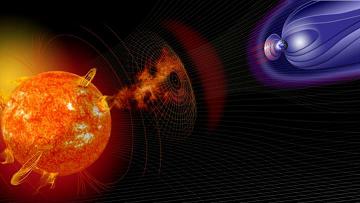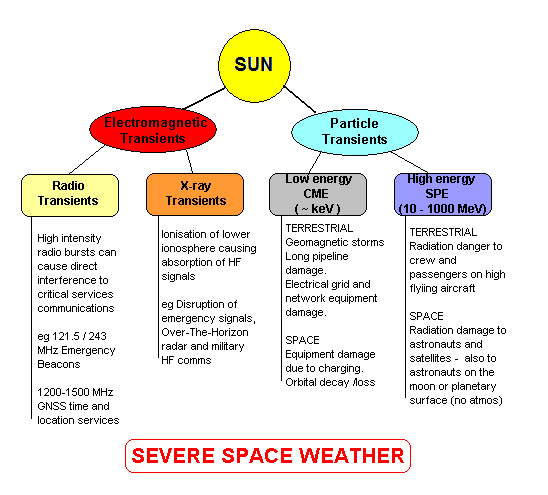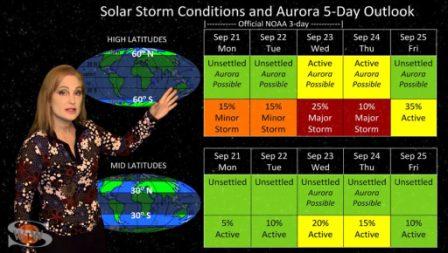



SPACE WEATHER
There is always space weather, just as there is always terrestrial weather. However, when the terrestrial weather is calm with clear skies, no clouds and balmy temperatures we tend not to think about the weather.
In just the same way, when the solar wind is flowing smoothly past the Earth at an average speed of 400 km/sec with a particle density of 7 protons per cubic centimetre and there are no disturbances in the Earth's magnetosphere of ionosphere we barely give thought to space weather.
However, when storms arise in the Earth's troposphere and heavy rains fall, maybe with strokes of lightning, we most definitely notice the terrestrial weather. In like fashion, when the Sun gushes forth a large cloud of matter which races through the interplanetary medium striking the Earth's magnetosphere and creating a large geomagnetic storm which produces aurora and maybe creates damage to an electrical power grid, we suddenly become very aware of space weather.
Not all space weather disturbances can be classified as severe space weather. A small solar X-ray flare may be hardly noticed by most of the Earth's population. So how do we define severe space weather? Various space weather forecast centres around the world nave developed a range of indices (just like the Beaufort wind velocity scale) to quantify the effects of space weather. However, these scales mean different things to different people. What may be significant to one group may be insignificant to another.
An overarching definition of severe space weather should probably consider space weather to be severe when it (1) involves danger to life, or (2) results in significant monetary loss to society
The rest of this note will define and discuss the various solar events that can produce severe space weather.
OVERVIEW OF SEVERE SPACE WEATHER

The following paragraphs will expand upon these solar events that may cause severe solar weather in the near Earth environment.
ELECTROMAGNETIC EFFECTS
Because of its high temperature (~6000 K) the Sun is a very broad band emitter of electromagnetic energy - from the lowest frequencies in the radio spectrum to soft X-rays - even in quiet conditions. In active conditions the intensity of these emissions increases, at least from specific regions of the Sun. The frequency range of these localised emissions can also increase and take in hard X-rays and even gamma ray emission for the most energetic transient events.
Solar electromagnetic emissions in the infrared and visible spectral regions do not show much variation over time. This is probably just as well, considering that it is these emissions that provide the heat energy to the Earth to make it habitable. Careful satellite measurements over extended periods of time have shown that the total solar electromagnetic output (>99% IR and visible) varies by an average of 0.1% over the 11 year solar cycle with some transient variations peaking to less than 1%.
Rapid (minutes to hours) transient variations in the radio and X-ray spectra can however show changes over 6 orders of magnitude. It is these transients that can cause some severe space weather.
Solar radio emissions in quiet times normally do not affect radio systems (communication, navigation, etc). Exceptions are radio systems pointing at the Sun. Every equinox satellite downlinks are often disrupted as the affected satellite in geosynchronous orbit slides behind the solar disc for an hour or two. However these are not normally life-threatening outages not do they cause significant financial loss to their operators.
However, during transient radio events, when solar radio signals increase by several orders of magnitude there are a few conditions in which life threatening conditions may occur.
One of these involves emergency locator beacons which are carried by most aircraft, many ships and even people trekking in isolated remote areas. Emergency transmissions can also be broadcast by aircraft and ships. Typical frequencies for emergency use are 121.5 MHz (civil aviation), 243 MHZ (military aviation), 156.8 Mhz (Channel 16 VHF marine) and 406 MHz for beacons which transmit to the ground stations via the satellite SARSAT system. The first two frequencies on beacons use very low power (to extend the beacon life) and are very susceptible to 'jamming' by solar radio transients.
The exact solar signal required to render an emergency transmission inaudible depends on several factors, and in particular the distance of the emergency transmitter from the receiving station. For the 406 MHz beacons the VHF signal to the satellite can be disrupted because the Sun may be in the beamwidth of the necessarily wide beam satellite receiver, or the satellite downlink may be subject to solar interference.
It is difficult to place a solar radio burst threshold on this phenomenon, but 1000 SFU for VHF is probably a good lower limit above which problems might be expected. One SFU = 10-22 W m-2 Hz-1.
Another life threatening situation is direct solar radio interference to global navigation satellite systems ( GPS, GLONASS, GALILEO, COMPASS/BEIDOU etc). Not only do these provide precision location services in life threatening operations (eg aircraft landings), but they are now widely used to provide precision timing services.
The life threatening circumstances through GNSS denial during aircraft landing operation or during military aircraft and missile strike operations are readily apparent. However, it has been pointed out that stock exchange transactions are now tied to these time services, and that critical transactions during volatile conditions are sometimes dependent of millisecond time scales for monetary amounts upwards of a million dollars.
The event threshold for GPS disruption is again quite variable, but it is generally quoted to start at 10,000 SFU with any burst >100,000 SFU being guaranteed to cause widespread disruption. Fortunately such bursts are rare. However, in December of 2006 a series of solar radio bursts with intensity in excess of one million SFU. This intensity was estimated as most dedicated solar radio telescopes saturate well below this level. It should also be noter that at this time the Sun was well on the way to sunspot minimum. So take note that not all severe solar weather occurs around sunspot maximum. Isolated events can and do occur at any time.
Solar X-ray emissions do not reach the Earth's surface. They are absorbed in the lower layers of the upper atmosphere around 100 km altitude. Even the highest energies and intensities during X-ray flares rarely penetrate to below 50 km.
The absorption of solar X-rays in the upper atmosphere creates an ionised (ionospheric) layer termed the D-layer, which absorbs high frequency (below 30 MHz) radio signals that would otherwise be reflected by higher altitude ionosphere layers (the E and F layers). This produces a shortwave fade during an X-ray flare. The reason the D-layer absorbs HF radio signals rather than reflect them as do the higher layers is because the density of air molecules is much greater at the lower altitudes. The collision frequency between the electrons produced by solar X-rays and the neutral atmospheric molecules is thus high. High enough to remove the electrons and the energy the have acquired from a radio signal before they have a chance to reradiate it back to the Earth.
By our definition of severe space weather, whenever space weather produces a condition that might endanger life or causes a large financial loss then we have severe space weather event. Although many countries now use satellites for emergency communications, there are still many populations, particularly in Asia and Africa where HF is the only medium available for emergency situations.
Solar X-ray flares are normally categorised by their total power measured by a satellite in geosynchronous orbit in the wavelength range from one to 8 Angstroms (0.1 to 0.8 nm). Categories are assigned by a letter followed by a number according to this output. The lowest significant category is C1 to C9 which corresponds to an energy range of 1 x 10-5 W m-2 to 9 x 10-5 W m-2. This is followed by M1 to M9 and then X1 onward. No further letter categories are assigned and a flare above X9 is simply given a large numeric qualifier (eg X13). The satellite X-ray detectors saturate at around X17 and more intense flares (which do occur) are estimated by extrapolation (eg X28).
For most communication systems solar X-ray absorption effects start to be noticed at around the M2 level. Complete loss of the HF spectrum occurs at about the X7 level and can last for two hours or more.
A more sensitive HF system than most is a military Over The Horizon Radar (OTHR). A large solar induced OTHR outage for a few hours might give an enemy based on a Pacific island time to fly a large bomb to the populated east cost of Australia virtually undetected.
SOLAR PARTICULATE EMISSIONS
Particles are continuously being thrown off by the Sun, ejected through the outer atmosphere (the Corona) into the interplanetary medium. The quiet solar emission is essentially due to the high solar temperature, 6000 K at the photospheric surface, rising to around two million Kelvin in the Corona. The average energy of protons in this environment is about 200 eV and the average velocity is about 200 km/s.
The Sun's escape velocity is a little over 600 km/s so a small fraction of the protons in the Corona will have velocities greater than this and will stream out from the Sun forming a constant 'solar wind'. At the Earth's orbit the average speed of this stream is around 400 km/s and the particle density is about 7 protons per cubic centimetre. As the solar plasma is essentially electrically neutral there will also be an equal number of electrons.
On occasions there will be a release of magnetic energy which will accelerate a cloud of coronal matter into the interplanetary medium - a coronal mass ejection (CME). The particle cloud is tied together by embedded coronal magnetic fields which are dragged along by the CME and eventually disconnect from their coronal source.
The total mass of plasma (mainly protons and electrons) ejected into the CME can range from under a billion tons (1012 kg) to over fifty billion tons. The size of CMEs can easily exceed a linear dimension of several million kilometres (dwarfing the solar diameter).
Another transient particulate emission from the Sun is referred to as a solar particle event or SPE. These high energy particles are not confined by coronal magnetic fields and have energies large enough to make them a dangerous source of ionising radiation to both man and matter.
Coronal Mass Ejections are clouds of low energy particles (plasma) with average energies in the keV range. Their speeds in the interplanetary medium can range from around 100 to 3000 km/s giving them transit times from half a day to several days to reach the Earth (if they happen to be travelling in that direction). They travel out from the Sun in an Archimedean spiral which intersects the Earth's orbit at an angle of about 45 degrees. High velocity CME's will be preceded by a shock wave formed because they are supersonic in the interplanetary medium.
The interaction of the CME with the Earth depends very much upon the direction of the vertical component of the interplanetary magnetic field near the Earth. If the field is negative - that is, oriented southward out of the ecliptic plane - the CME plasma will not easily be able to enter the Earth's magnetosphere. If it is positive it will have much easy access. This can be likened to two bar magnets approaching each other. If their magnetic polarities are aligned (positive to positive or north to north) they will repel, if their polarities are opposite they will attract.
Generally the CME plasma will stream past the terrestrial magnetopause sunward boundary, travel along the magnetotail, which streams out in the anti-solar direction. The plasma may find entry at this point where the terrestrial magnetic field lines are open, and it will then accelerated back toward the Earth. A large CME will increase the particle density in the magnetosphere. Subsequent events may dump this load lower in the Earth's upper atmosphere, after which the magnetosphere may be refilled and the process repeated.
The initial contact between the CME and the magnetosphere may compress the magnetosphere and this is registered on ground based magnetometers as a sudden increase in the magnetic field. This is known as a sudden storm commencement (SSC) and is the first indication that a CME has arrived has arrived at the Earth. The subsequent magnetosphere-CME interactions is seen on magnetometers as a series of large oscillations known as bays over the next few hours to days. Larger CME's will produce higher intensity magnetic storms and last for longer periods of time.
The intensity of a geomagnetic storm is indicated by the planetary Kp index which ranges from zero in very quiet magnetic conditions to 9+ in really severe magnetic storms. Normal geomagnetic activity can have Kp ranging from 0 to 3. A mild magnetic storm would be indicated by Kp values of 4 to 5 and a major storm by values of 6 to 7. Anything above 7 indicates a severe storm.
The most obvious effect of a magnetic storm is the production of aurorae. However, while beautiful it can hardly be regarded as hazardous. It is produced when particles are deposited into the base of the upper atmosphere (around 100 to 300 km in altitude).
The injection of particles into low Earth orbit (LEO) causes increased drag on satellites (and space debris) in this region and lowers their altitude. This orbital change can help remove debris (by lowering their orbits so they more rapidly re-enter the Earth's lower atmosphere and burn up). However, it can also be a nightmare for satellite trackers who are trying to keep track of all the satellites in LEO. In 1991 a large CME resulted in the US Air Force space track facilities losing track of over 30% of all LEO assets. It took three months to re-identify all these lost satellites. The situation would be a lot worse today, both because of vastly increased LEO satellite numbers and the absence of really wide beamwidth sensors to track large numbers of unknown objects (because of decommissioning). The storm which caused this problem was a magnitude Kp=9 event.
In space a large geomagnetic storm can also result in electrostatic charging of satellite surfaces. Subsequent rapid electrostatic discharge (ESD) can damage components interior to the satellite and even render the satellite inoperable.
On the ground, a geomagnetic storm can induce large voltages (which can result in large currents) in long conductors such as pipelines or electrical grids. In the latter case effects can range from system overload to switchgear and transformer damage. In August 1972 in New York, a CME resulted in New York City being without power for 24 hours. A secondary consequence of this was that 9 months later there was a mini population explosion (if you can't watch TV....)!
On March 13, 1989 there was an even larger geomagnetic storm which caused damage to the electrical grid (melting transformers) of HydroQuebec and resulted in widespread outages over much of north-eastern America and Canada. This storm was classified as Kp=9++ (one analyst said that if the scale went higher it would have been a Kp=12 event).
On many occasions a large geomagnetic storm (in the magnetosphere above the ionosphere) will result in an ionospheric storm causing uncertain HF operation for systems that reply on the ionosphere for over the horizon signal paths.
The last category of severe space weather is a Solar Particle event. This is caused by highly energetic particles with energies from 10 to 1000 MeV. This is sufficient to penetrate living tissue and inanimate objects and cause significant radiation damage.
There is a story about a cosmic ray research group at a UK University that was commissioning a new cosmic ray telescope in 1953. When they threw the switch they obtained count rates that they knew were much higher than they were expecting. Grudgingly they took the equipment apart, looking for a fault. Finding none they put the CR detector back together. At the recommissioning they were absolutely dismayed to find out that they had just missed one of the largest SPE's in recent history! There had been nothing wrong with equipment.
The above story illustrates that an SPE can have an effect on the surface of the Earth. Such an SPE is also referred to as a Ground Level Event (GLE). For smaller SPEs the radiation has usually been absorbed by the atmosphere before it reaches the ground. However, even in the stratosphere high levels of radiation from an SPE can be observed in high altitude aircraft flights, particularly at latitudes higher than 40 degrees. The closer to the poles, usually the higher the dose. Ground level riometers at Antarctic stations can be used to monitor SPE's.
In aircraft flights that use stratospheric altitudes and high latitudes (particularly USA to Europe over the north pole), pilots must carry personal dosimeters, and if it is found that they have received a critical transient radiation dose, or even a critical accumulated dose they may be transferred onto different flight activities where high radiation doses are less likely. Pregnant flight crew are usually prohibited from flying potentially high risk radiation routes.
The important factor in SPE categorisation is the radiation dose, in Grays (Gy) for inanimate objects and in Sieverts (Sv) for living tissue. This will range from around 10 to 10,000 milli-Sieverts (approximately the same in Grays). One mSv corresponds to the average annual dose we receive both from our terrestrial environment and galactic cosmic radiation. 4,000 mSv is the so called LD50-30 dose, the lethal dose for 50% of the human population in 30 days.
In August 1972 a large SPE occurred in the time frame between the last two Apollo lunar missions. It was calculated that an astronaut in a space suit on the lunar surface at that time would have receiver a dose of 3,000 mSv. If he made it back to Earth he would have been very sick and may even have died. The disabling sickness they would have suffered may have made it impossible for the crew to carry out their duties to even return to Earth. (Astronauts inside the lunar or command modules would have received less dose than outside in a spacesuit).
There appear to be at least three different mechanisms whereby solar particles (mainly protons) are accelerated to the high energies observed in SPE's. The arrival time at Earth may be as little as 10 minutes to a few hours after any other indication is manifest at Earth. SPE's are thus difficult to predict and can give very little warning.
Satellites are affected by SPE's due to direct component radiation damage, either externally or to internal equipment. In the 1980's a large SPE reduced the lifetime of solar panels on several geosynchronous communication satellites by over 30%. With the cost of a typical commsat being around $300 million, this corresponds to a financial loss of $100 million for each satellite.
REFERENCES

 Australian Space Academy
Australian Space Academy